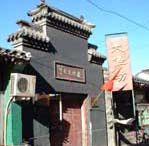
Most of us are concerned with avoiding annoying shocks from static electricity, breaking out humidifiers and simply staying warm now that winter has arrived. With the days getting colder and nights growing longer, the urge to hibernate glued to the TV with a stack of DVDs is almost irresistible.
Around Town wants to fire you up and suggests taking a trek to check out three of Beijing's surviving Fire God temples, generically called Huoshen Miao and Huo De Zhen Jun Miao.
The Chinese God of Fire dates back to remote antiquity. There's no definitive explanation for the origin of this deity, however the most commonly accepted version is that in the Book of Rites, a work edited in the Han dynasty (206 BC-24 AD) from material written in the Zhou dynasty (c.1100-770 BC). The god started as a man, Zhu Rong, who served as a Minister to China's mythical Huangdi (Yellow Emperor).
The tradition of worshipping the Fire God changed over time from honouring its discoverer to becoming a form of superstitious supplication. The function of this spirit was to punish evil doers by setting their houses afire.
The practice in old Beijing was to make a paper shrine with an image of the god, carry it in procession to a fire god temple on his birthday (lunar calendar dates vary), and then torch it. Another method used to ward off the Fire God's wrath played upon his reputation as a prude. Erotic pictures were sometimes hung in kitchens or inside roof beams to prevent his visitation.
This was a third-level spirit in pantheistic worship. Many Taoist and Buddhist temples had a Fire God shrine within their confines, but not as the main icon. Nevertheless, research done by Princeton historian Susan Naquin indicates that during the Ming (1368-1644) and Qing (1644-1911) dynasties Beijing had at least 56 temples dedicated to the Fire God as the primary or secondary figure.
Chongwen Fire God
Next to the building at 103 Xihuashi Dajie (West Flower Market Boulevard) in Chongwen District is one of Beijing's Fire God temples in the process of making a phoenix-like reappearance. Until last year it was the least preserved structure in the area, a dazayuanr, meaning a "mixed courtyard"
The mix was a warren of brick shacks occupying the two courtyards while temple rooms had been subdivided among families. The former occupants are gone and the Huoshen Miao is getting a complete restoration. Unfortunately the siheyuan and hutong in this historic Muslim Quarter are in the final throes of being torn down as you now read this article. Fortunately the mosque dating from 1444 was spared but is now surrounded by apartment blocks and scaffolding.
The Fire God temple was built in 1568 by the Ming emperor Longqing (r. 1567-1572). Temple fairs were held the on the 4th, 14th, and 24th of each lunar month. The front gate (shanmen) and main idol consisting of an animal's body and human head disappeared in the late 1950s when it became housing. Some of the old glazed tiles taken down during ongoing repairs bear the mark of the Gong Bu, the Imperial Works Department.
Xicheng Fire God
Shichahai, the proper name for the popular area called Houhai in Xicheng District, means "Ten Temples of the Seas." One of the oldest temples here is dedicated to the God of Fire. There's a legend that it dates back to the Tang dynasty (618-907).
Located at 77 Di'anmenwai Dajie on the northwest side of the Wanning Bridge, the Fire God Temple was restored in 1346 by Toghon Temur (r. 1333-1368) last emperor of the Yuan dynasty (1271-1368). Major restorations also took place during the reign of Ming Emperor Wanli (r. 1573-1620), Qianlong of the Qing and are underway again right now at a snail's pace.
This site had been a dazayuanr made into housing for half a century, although not quite as cramped and densely packed as the temple in Chongwen.
Xuanwu Fire God
There's a Fire God temple at 29 Liulichang Dongjie, near the northeastern end of Beijing's famed antique market street in Xuanwu District. The temple was established by police authorities during the reign of Qing emperor Qianlong (r. 1736-1795) as a method of fire prevention in this densely crowded district.
During its glory days, this temple was used as a meeting place and showcase for traders of luxury goods. From the fourth to fifteenth day of the Lunar New Year celebrations, representatives from the jewel, curio, and jade guilds located outside Qianmen met here to sell and display precious and semi-precious stones as well as intricately carved jades and ivories in a wide variety of motifs. Some examples were said to rival pieces in the Forbidden City.
Nowadays the fire has gone out. The structure belongs to the district's Writers' Association and Cultural Relics Bureau. While not open to the public, it's usually OK to take a look around inside although there's not much to see.
Rather than be burned by the experience, head further east on the street to No. 14, the Songtangzhai Museum. It's a very nice little place dedicated to the Chinese genius in stone and wood carving. Admission is free, but making a donation is suggested. It's open 9:30 am to 6 pm every day but Monday. If you speak Mandarin, call 8316-4663 for info.
(Beijing Weekend November 21, 2003)
|

